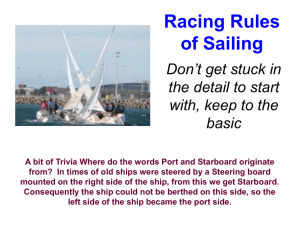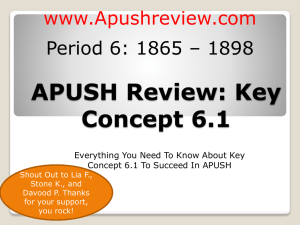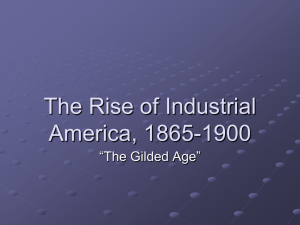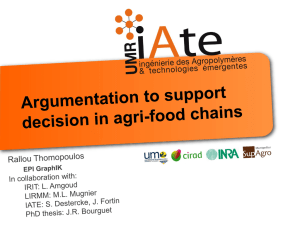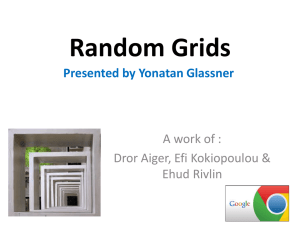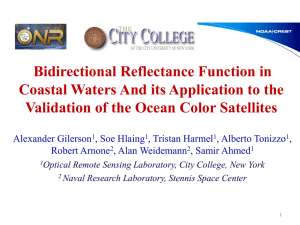Kd(443)
advertisement
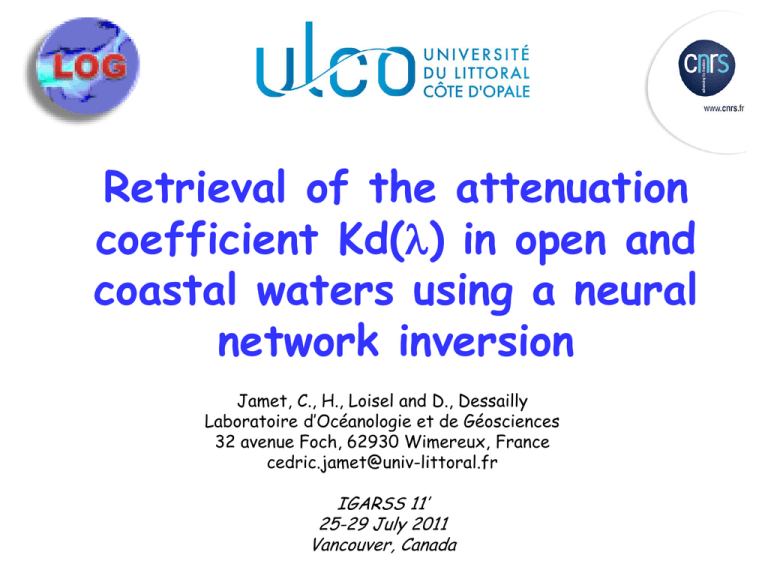
Retrieval of the attenuation coefficient Kd() in open and coastal waters using a neural network inversion Jamet, C., H., Loisel and D., Dessailly Laboratoire d’Océanologie et de Géosciences 32 avenue Foch, 62930 Wimereux, France cedric.jamet@univ-littoral.fr IGARSS 11’ 25-29 July 2011 Vancouver, Canada Purpose of the study (1/2) • Diffuse attenuation coefficient Kd() of the spectral downward irradiance plays a critical role: – Heat transfer in the upper ocean (Chang and Dickey, 2004; Lewis et al., 1990; Morel and Antoine, 1994) – Photosynthesis and other biological processes in the water column (Marra et al., 1995; McClain et al., 1996; Platt et al., 1988) – Turbidity of the oceanic and coastal waters (Jerlov, 1976; Kirk, 1986) Purpose of the study (2/2) • Kd() is an apparent optical property (Preisendorfer, 1976) varies with solar zenith angle, sky and surface conditions, depth • Satellite observations: only effective method to provide large-scale maps of Kd(490) over basin and global scales • Ocean color remote sensing: vertically averaged value of Kd(490) in the surface mixed layer State-of-the art (1/3) • Direct one-step empirical relationship: – Werdell, 2009: • Kd(490)= 10 ( 0 . 8515 1 . 8263 X 1 . 8714 X 2 2 . 4414 X 3 1 . 0690 X 4 ) 0 . 0166 with X=log10(Rrs(490)/Rrs(555)) (SeaWiFS/MODIS standard algorithm) – Zhang, 2007: • If (Rrs(490)/Rrs(555)) 0.85, Kd(490)= 10 ( 0 . 843 1 . 459 X 0 . 101 X 2 0 . 811 X 2 0 . 021 X 3 ) 0 . 0166 ) 0 . 0166 with X=log10(Rrs(490)/Rrs(555) • If (Rrs(490)/Rrs(555)) < 0.85, Kd(490)= 10 ( 0 . 094 1 . 302 X 0 . 247 X with X=log10(Rrs(490)/Rrs(665) 3 State-of-the art (2/3) • Two-step empirical algorithm with intermediate link – Morel, 2007: 2 3 4 (0.3272 - 2.9940 * X 2.7218 * X -1.2259 * X - 0.5683 * X ) • chl-a= 10 with X=max(Rrs(443),Rrs(490),Rrs(510)) (OC4V6) • Kd(490)=0.0166 + 0.0733[chl-a]0.6715 • Semi-analytical approach: – Lee, 2005 AOPs determined by IOPs: • Kd()=(1+0.005*s)*a() + 4.18*(1-0.52*e-10.8.a())bb() with a() and bb() calculated from Rrs() through radiative transfer equations State-of-the art (3/3) •Open ocean (Lee, 2005) : • All methods give accurate estimates • Coastal waters (Lee, 2005) : •Empirical methods: significant errors except for Zhang (2007) •Semi-analytical: not such limitation but accuracy still low Way to improve the estimation • Use of artificial neural networks MultiLayer Perceptron (MLP) – – – – Purely empirical method Non-linear inversion Universal approximator of any derivable function Can handle “easily” noise and outliers • Method widely used in atmospheric sciences but rarely in spatial oceanography Principles of NN • • • A MLP is a set of interconnected neurons that is able to solve complicated problems Each neuron receives from and send signals to only the neurons to which it is connected Applications in geophysics: – Non-linear regression and inversion (Badran and Thiria, J. Phys. IV, 1998; Cherkassky, Neural Networks, 2006) – Statistical analysis of dataset (Hsieh, W.W, Rev. Geophys., 2004) y1 x1 x2 f y2 y3 Advantages: Limits and drawbacks: • Universal approximators of any nonlinear continuous and derivable function • Multi-dimensional function •More accurate and faster in operational mode • Need adequate database • Learning phase is time consuming • Number of hidden layers and neurons unknown: need to determine them Dataset • Learning/testing datasets Calibration of the NN – NOMAD database (Werdell and Bailey, 2005): • 337 set of (Rrs,Kd()) per wavelength – IOCCG synthetical dataset (http://ioccg.org/groups/lee.html): • 1500 set of (Rrs, Kd()) per wavelength • Three solar angles: 0°, 30°, 60° • 80% of the entire dataset randomly taken for the learning phase (e.g., determination of the optimal configuration of the artificial neural networks) • The rest of the dataset used for the validation phase Rrs(443) Rrs(490) Rrs(510) Kd() Rrs(555) Rrs(670) Architecture of the Multi-Layered Perceptron: Two hidden layers with four neurons on each layer Dataset • Learning/testing datasets Calibration of the NN – NOMAD database (Werdell and Bailey, 2005): • 337 set of (Rrs,Kd()) per wavelength – IOCCG synthetical dataset (http://ioccg.org/groups/lee.html): • 1500 set of (Rrs, Kd()) per wavelength • Three solar angles: 0°, 30°, 60° • 80% of the entire dataset randomly taken for the learning phase (e.g., determination of the optimal configuration of the artificial neural networks) • The rest of the dataset used for the validation phase NN RMS (m-1) Relative Slope error (%) r 0.175 0.98 10.35 1.01 Statistics on the test dataset Comparison with other methods • COASTLOOC DATABASE (Babin et al., 2003) – Observations in European coastal waters between 1997 and 1998 – Entirely independent dataset from NOMAD and IOCCG – Kd(490) ranging from 0.023 m-1 and 3.14 m-1 with a mean value of 0.64 m-1 – Nb total data: 132 • Comparison of Kd(490), Kd(443) Werdell Zhang Morel Lee NN RMS 0.924 0.337 0.695 0.351 0.204 Relative error (%) 44.96 29.81 48.83 38.06 36.07 Slope 0.14 1.34 1.28 0.92 1.06 Intercept 0.57 -0.08 0.33 0.03 -0.00 r 0.19 0.87 0.34 0.81 0.94 Comparison for Kd(443) • Werdell – Empirically extrapolated from Kd(490) following approach of Austin and Petzold (1986): • Kd(443)=0.0178 + 1.517*(Kd(490) – 0.016) • Morel: – Kd(443) is calculated like Kd(490) with only difference being the spectral values: 0.0085 for Kw(443), a0(443)=0.10963 and a1(443)=0.6717 • Lee: – Kd(443) calculated same way that for Kd(490), a(443) and bb(443) being calculated from Rrs(443) Werdell Morel Lee NN RMS 1.113 1.026 0.625 0.279 Relative error (%) 49.55 61.47 47.34 29.04 Slope 0.22 0.47 0.68 0.94 Intercept 0.83 0.47 0.13 0.08 r 0.22 0.38 0.79 0.96 Flexibility of the NN • NN learned for =443, 490, 510, 555, 670 nm • But is an input parameter • Is it possible to forecast a Kd at another wavelength ? • Test for Kd(456) with the COASTLOOC database Kd(450) NN RMS Relative error (%) Slope r 0.250 31.65 0.96 0.96 Conclusions and Perspectives • On the used dataset: – Net overall improvement of the estimation of the Kd() – Same quality for the very low values of Kd(490), i.e. < 0.2 m-1 – Huge improvement for the greater values, especially for very turbid waters (Kd(490) > 1 m-1) • More tests of the useful inputs parameters: solar zenithal angle? • Duplicate work for MODIS and MERIS sensors Acknowledgments • CNRS and INSU for funding • Marcel Babin for providing the COASTLOOC database • IOCCG for providing the synthetical database • NASA for providing the NOMAD database K d ( , z ) 1 dE d ( , z ) E d ( , z ) dz State-of-the art (1/3) • Direct one-step empirical relationship: – Mueller, 2000: • – Werdell, 2005: • – Werdell, 2009: • Kd(490)=0.1853.X-1.349 with X=Rrs(490)/Rrs(555) Kd(490)=0.016 + 0.1565.X-1.540 with X=Rrs(490)/Rrs(555) ( 0 . 8515 1 . 8263 X 1 . 8714 X Kd(490)= 10 2 2 . 4414 X 3 4 1 . 0690 X ) 0 . 0166 with X=log10(Rrs(490)/Rrs(555)) (SeaWiFS/MODIS standard algorithm) – Zhang, 2007: • If (Rrs(490)/Rrs(555) 0.85, Kd(490)= 10 ( 0 . 843 1 . 459 X 0 . 101 X 2 0 . 811 X 3 ) 0 . 0166 2 0 . 021 X 3 ) 0 . 0166 with X=log10(Rrs(490)/Rrs(555) • If (Rrs(490)/Rrs(555) < 0.85, Kd(490)= 10 ( 0 . 094 1 . 302 X 0 . 247 X with X=log10(Rrs(490)/Rrs(665) Impact of the estimation of the inherent optical properties of seawater • Loisel et al. Model: Estimation of the inherent optical properties of the seawater: absorption, scattering coefficients • Equation: b b K d 1 10 a [ R rs ] d a ( 0.83 5.34 h 12.26 h2) mw(1.013 4.124 h 8.088 h2) d (0.871 0.4 h 1.83 h2) Performance of the new model at 490 nm using the IOCCG synthetic data set. New model with previous Kd parameterizations New model with Kd estimated from Neural Network The Kd-NN allows to decrease the RMSE of bbp and atot-w by a factor of 1.92 and 1.6, respectively. New model with Kd estimated from Neural Networks on the NOMAD data set Monitoring the diffuse attenuation coefficient Kd() in open and coastal waters from SeaWiFS ocean color images Jamet, C., H., Loisel and D., Dessailly Laboratoire d’Océanologie et de Géosciences 32 avenue Foch, 62930 Wimereux, France cedric.jamet@univ-littoral.fr IGARSS 11’ 25-29 July 2011 Vancouver, Canada
